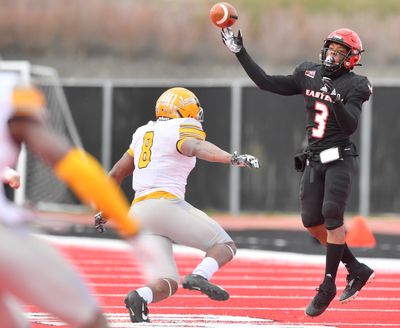Eastern Washington University will keep football team, remain in Big Sky and NCAA Division I

After months considering how to proceed with college athletics, the Eastern Washington University Board of Trustees voted Friday to continue competing in the NCAA Division I’s Big Sky Conference with a football team.
The board voted 6-1, with student trustee Abigail Greiner opposed, to support a recommendation presented by Interim President David May on the future of EWU athletics. Board Chair Vicki Wilson disconnected from the Zoom meeting at the time of the vote because of a technical glitch.
In an effort to forge a more sustainable budget for the department, May recommended a model to pull back on fully supporting some sports programs to continue competing in the Big Sky.
Speaking as a 40-year alumna of EWU, Wilson said the direction “is the right thing to do.”
“I talk to many, many people about Eastern,” Wilson said. “Lots of times, that conversation starts with athletics, but it always moves into our academics and our programs and what it is doing for our students right now and what it has done for our students 40 years later.”
The way certain sports programs will be affected has not been decided. With a direction in place, May said he will have discussions this summer with university leaders, including Athletics Director Lynn Hickey, to decide a funding structure for EWU athletics into the future.
May said he hopes to present a full report to the board by October.
“We are so appreciative of the public support Eagle Athletics continues to receive, and that enthusiasm was reaffirmed today as our Board of Trustees voted to accept the recommendation from David May,” Hickey said in a statement. “This is also a call to action, and we are committed to continued improvement in being more efficient in operations and fundraising as well as working to strengthen our engagement with the whole campus.”
The recommendation was one of several possibilities presented to the university in a report by The PICTOR Group, a consultant group EWU hired last year.
As presented by the PICTOR report, the model recommended by May would reduce expenses mainly through the elimination of grants-in-aid to lower-tier sports programs, adoption of scheduling restrictions and possible reductions in coaching staff.
Other options included moving to a lower NCAA division or dropping the football program.
In outlining her opposition to the board, Greiner said she would recommend to move EWU athletics to Division II and the Great Northwest Athletic Conference where Central and Western Washington universities compete.
She said her recommendation was based on the responses she reviewed in community and campus surveys taken with the PICTOR report. Particularly with the student responses, Greiner said she noticed students fall into two camps: those who feel EWU is spending too much on athletics or those who would leave the school if Eastern completely cuts athletics.
Greiner said those concerns could be resolved with moving to a division “that is better suited for us.”
“When we discuss all of the resources and the places and the basketball court and the track and field, it needs more money,” she said. “And I think rather than trying to continually fund Division I at the level that we are and … putting all of our money into keeping it there, moving to Division II would allow us … a cheaper way to stay in athletics, and that money can go to where athletics truly needs it into making those changes, into making a better system overall for its students rather than having to pick and choose sports.”
In addition to restructuring the athletics budgeting, May’s plan hopes for increased levels of philanthropy from donors and the community.
The PICTOR Group’s report stated EWU would need millions in additional investment annually to remain a Division I Big Sky school.
Trustee Jay Manning said he heard from many in the community who were vocal about keeping EWU in the Big Sky.
“Many of them have been very liberal in their giving to the university,” Manning said, “but we’re going to need them to step up more, and we’re going to need those who want to stay Division I, but haven’t been giving, that they step up and become part of the long-term financial strategy for athletics.
EWU Faculty Organization Vice President David Syphers, who co-authored a report last year that argued athletics spending would be better used on academics, decried the recommendation during the meeting’s public comment period.
He compared the athletics program to mistletoe, a “pretty” and “parasitic” plant that draws nutrients from its host, thereby stunting the host’s growth. In particular, Syphers referenced how the university’s level of donor funding is about $300,000 – “a drop in the bucket compared to what we need.”
“If you decide Eastern should be a sports-first, academics-second university, that’s your call,” Syphers said, “but that is not the kind of university I want to work at and it’s not the kind of university that most of our students want to attend.”
Several board members took umbrage with Syphers’ comments.
Trustee Robert Whaley described the “athletics-first” comment as “ill-conceived,” saying if he felt like he was doing that, he “would probably resign.”
“If I believed Eastern was going to be a better university by getting out of Division I and moving to Division II, as Abigail suggested, or dropping football, I’d do that – and I’m not afraid of doing that,” Whaley said, “But I look at what the athletic departments have done at Eastern, and I’m extraordinarily impressed with the academic and athletic performance.”